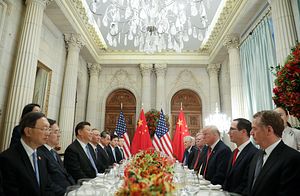The dust has settled in the trade war between the United States and China. After their hotly anticipated dinner meeting in Buenos Aires, Argentina, on the sidelines of this year’s G20 leaders’ summit, U.S. President Donald Trump and his Chinese counterpart Xi Jinping found the necessary ingredients for what amounts to a temporary truce.
The war isn’t over, but it’ll cool as 2018 comes to an end.
The G20 truce shouldn’t leave investors worry-free, but it is likely to give markets the short-term confidence needed to end 2018 on a high note.
The biggest headline is that both sides have agreed to temporarily hold off on the implementation of new tariffs.
Critically, that includes the previously slated January 1 increase from 10 to 25 per cent on some US$200 billion in Chinese goods.
Beijing, too, will hold off on escalating in the meantime with retaliatory action, working instead to purchase what the White House has said will be a “very substantial” amount of U.S. goods in the agricultural, energy, and industrial sectors.
This amounts to a tactical pause, giving both sides time to work out the details, both of how China will in the short-term live up its promise to buy U.S. goods and, more seriously, how the two sides will resolve the fundamental philosophical differences that continue to divide them on trade.
Beyond the staying of further tariff implementation, the second most important outcome of the G20 encounter is that we’re now entering another period of protracted uncertainty.
The United States and China will carry forward negotiations over a 90-day period; if that period expires without a satisfactory comprehensive agreement – an all too likely outcome – further escalation will take place.
This is where what wasn’t addressed at the G20 takes on particular importance. For example, the Trump administration’s concerns about China’s alleged theft of U.S. intellectual property remain in place and Beijing’s broader push for indigenous advances in its hi-tech sector under the aegis of the “Made in China 2025” initiative have yet to be addressed.
In the short-term, there is no deal just yet – only an agreement by both sides to freeze escalation as it stands today, buying time to work out a possible path.
As far as fundamental concessions are concerned, both Xi and Trump appear to have held fast.
The U.S. decision to agree to a delay in the imposition of the tariffs formerly scheduled for January 1 might yet be seen as a successful application of leverage.
Xi appears to have offered up non-trade measures to build goodwill in the relationship at a time of multiple converging tensions, from the South China Sea to Taiwan.
At the dinner, he agreed to designate fentanyl, the deadly synthetic opioid that contributes to America’s national crisis, as a controlled substance.
The designation will be a welcome gesture for the Trump administration, which declared the American opioid crisis a national public health emergency.
But, as with so many things, China’s follow-up will be what matters to ensure that what is meant to be a confidence-building measure endures.
Xi would do well to follow up this gesture with significant action against major fentanyl producers.
The meeting has offered another chance for Trump to get in the room with Xi.
The U.S. president is prone to take kindly to others when he meets them face to face. His reflections on the meeting suggest that, at least at the leaders’ level, the US-China relationship is in a better place than it was in October, following U.S. Vice President Mike Pence’s speech criticising a wide array of Chinese actions.
“This was an amazing and productive meeting with unlimited possibilities for both the United States and China,” Trump said in a statement released after Saturday’s meeting. “It is my great honour to be working with President Xi.”
The question now is what occurs in the next 90 days. Beijing will no doubt attempt to make good on its pledge to increase purchases of U.S. goods, turning probably to soybeans and potentially energy. That alone, however, won’t satisfy Trump’s most hawkish advisers on trade, including U.S. Trade Representative Robert Lighthizer and adviser Peter Navarro.
This is all to say that while investors might breathe easy in the coming days, it’s best not to lose sight of the forest for the trees.
The G20 outcome grants temporary respite, but does not come close to setting in place a clear way out of the trade war.
The deeper, fundamental divergences between the two sides will remain well in place and are unlikely to be ironed out in just 90 days.
This article first appeared at the South China Morning Post. It is republished here with kind permission.

































